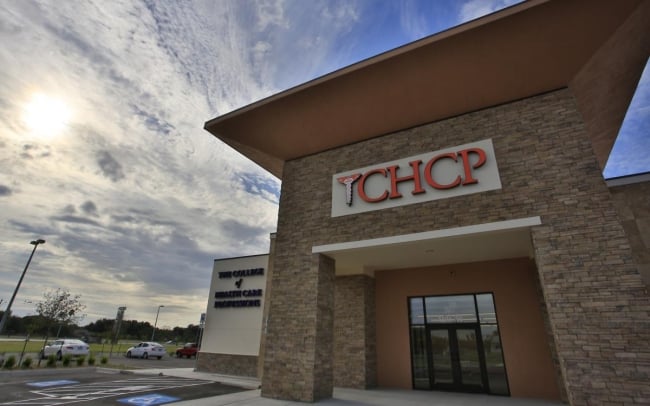You have /5 articles left.
Sign up for a free account or log in.

CHCP's campus in McAllen, Tex.
CHCP
The leader of a growing Texas college thinks his institution may have cracked the code for lifting students out of poverty and into careers in high-demand health-care fields. And he’s got student outcomes data to back that assertion.
Students who enroll at the College of Health Care Professions tend to arrive in “significantly distressed situations,” said Eric Bing, the college’s CEO. “Our goal is to stabilize.”
Most students have annual salaries of $9,000 to $15,000 when they first enter the for-profit college, which enrolls roughly 4,000 students and offers in-person, online and blended programs at its eight campuses across Texas. Students tend to get jobs and earn more than double their previous salaries after graduating from CHCP.
For example, the typical student in a medical assistant program at the college’s Austin campus is earning $12,300 when they enroll. But graduates of the certificate program earn a median wage of $25,200 in their first year after completing, according to federal data.
Associate degree programs at CHCP can lead to higher wages, like the median pay of $34,000 for graduates of the allied health diagnostic, intervention and treatment professions degree program at the college’s northwest Houston campus, according to federal data.
CHCP's students are diverse, as is Texas. More than half (56 percent) are Latino, 22 percent are black and 88 percent are women.
More than a third (36 percent) of students previously attended college -- typically a community college for two to three years -- but failed to graduate.
Many health-care companies are desperate to hire medical assistants, with federal data projecting a 23 percent expansion of the occupation over the next decade. Yet medical assistant training programs often are plagued by low graduation rates.
The College of Health Care Professions’ overall retention rate in the first year is 82 percent. Campus graduation rates hover around 75 percent or higher -- the Austin campus has an 81 percent graduation rate.
Meeting Employer Demand
Bing said the college’s responsibility doesn’t end with student completion.
“It’s about employment, not graduation,” he said.
As a result, CHCP focuses heavily on partnerships with employers across Texas, working to tailor programs to the needs of health-care providers. That approach is paying off -- the college has an overall job placement rate of 82 percent in their field of study.
“Our students are working on career readiness in their very first class,” Bing said. The college offers externships wherever students live, he said, adding that “all of our graduates have placement assistance for life.”
The College of Health Care Professions was founded 30 years ago by physicians at the Texas Medical Center. That in-house training ethos remains key to what it does today.
For example, CHCP in October launched a new associate degree program in surgical technology at its Austin campus. Those jobs, which typically pay more than $50,000 a year, are in high demand at Ascension Texas and Baylor Scott and White, two regional health-care providers.
Ascension first heard about the college from nurses and doctors, said Geronimo Rodriguez, chief advocacy officer at Ascension Texas and a former lawyer at the U.S. Department of Labor.
Local community colleges and other postsecondary providers have not been able to meet the demand for surgical tech employees, said Rodriguez.
“Nobody’s going to replace the community college,” he said. But Ascension needed another postsecondary partner. And CHCP was trusted by medical staff.
“They came in and asked, ‘What’s your biggest need?’” Rodriguez said of the college. “They listen and they respond.”
Rodriguez praised CHCP for getting the surgical tech program off the ground quickly, for its willingness to take risks and for having good outcomes and low relative student debt levels.
For example, the median debt load for students who attended the medical assistant program in Austin is $9,500, according to federal data.
More programs are in the works at the campus, Rodriguez said.
“The leadership of the CHCP understands the value of partnerships and relationships,” he said. “It’s a win-win. They’re delivering what we need.”
Stackable and Practical
The college has changed its approach substantially during the last five years, Bing said. For example, it’s increasingly working on direct training by conducting internal “upskilling” of employees at health-care companies.
CHCP also has begun creating stackable credentials, where students who earn certificates can progress -- while working -- to associate degree programs that build on their college credits and allow them to not waste time and money by retaking courses.
The college has no plans to add new standalone four-year degrees, Bing said. It has begun offering bachelor’s degree completion programs, but plans to stick to employment-focused medical training.
“There’s no medieval literature” in the curricula, said Bing.
Fees are flat and all inclusive. The typical certificate program costs $16,950 and can be completed in a little more than nine months. All students get laptops from the college, which pays for professional certification exams and does not charge fees beyond its tuition rate. As a result, debt loads tend to be manageable.
"The last thing we wanted to do was saddle first-generation, low-income students with student loans," said Rodriguez.
CHCP's newer campuses exclusively offer blended-online programs. The nine-month module includes two days of campus-based instruction and lab work.
“An employer will work around two days per week,” Bing said.
Enrollment at the college has been increasing steadily in recent years.
“We’ve been able to grow it using this price model,” said Bing. “I believe it is scalable.”
CHCP has not faced any of the regulatory missteps or allegations about low-quality programs that have dogged the for-profit-college sector in recent years. While credits earned at the college may not transfer to other institutions, the programs are short enough that transfer isn't common at the nationally accredited college. None of its programs would have failed or been in the warning zone under the Obama-era gainful-employment rule that the Trump administration dropped.
“The bad schools went out of business,” said Steve Gunderson, president and CEO of Career Education Colleges and Universities, the primary for-profit college trade group. “Most of those that are still here, there’s a reason they’re still here, because they do things well.”
Gunderson said roughly 85 percent of students enrolled at CECU’s member institutions can be deemed at risk. CHCP knows how to serve those students well, he said. Other proprietary colleges Gunderson pointed to with solid results in allied health fields include Success Education Colleges and Pima Medical Institute.
One reason those institutions do well, he said, is because they know they’re in the employment business, not just the education one.
Bing agreed. He argued that more colleges, particularly those with health-care programs aimed at low-income students, should consider breaking out of the traditional structures of higher education.
“It’s built around people with crazy busy lives,” Bing said of CHCP. “If we can get them through those nine months, they’re never going to fall into poverty.”








